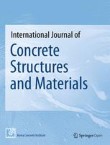International Journal of Concrete Structures and Materials is affiliated with Korea Concrete Institute.
Image Analysis and DC Conductivity Measurement for the Evaluation of Carbon Nanotube Distribution in Cement Matrix
The present work proposes a new image analysis method for the evaluation of the multi-walled carbon nanotube (MWNT) distribution in a cement matrix. In this method, white cement was used instead of ordinary P...
